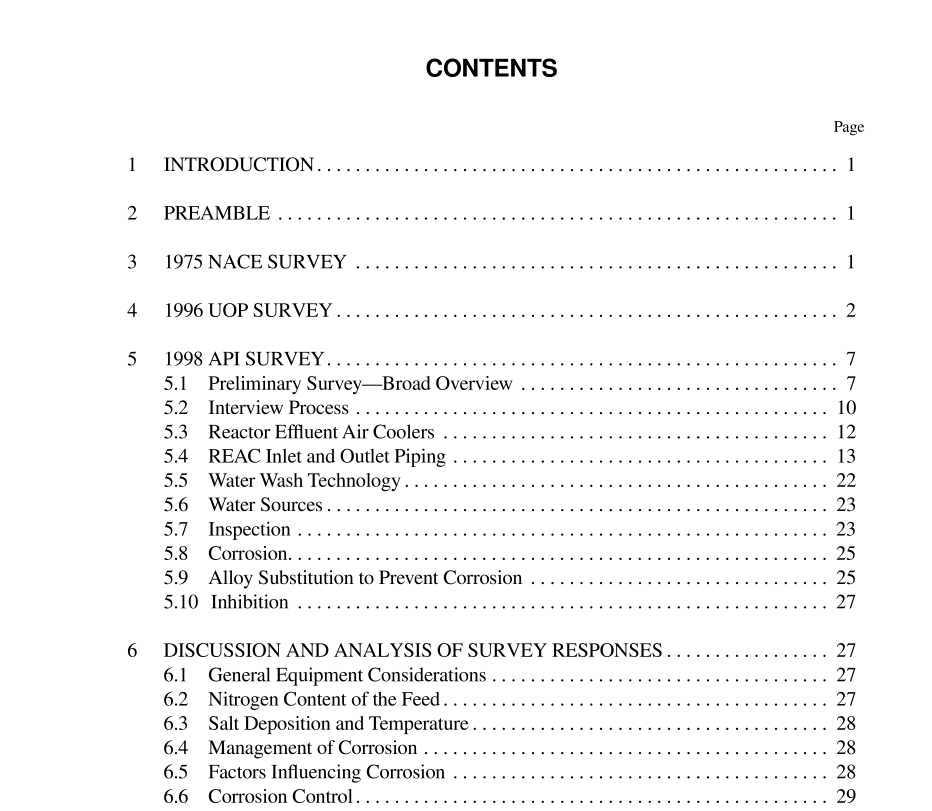API PUBL 932-A pdf download

API PUBL 932-A pdf download.A Study of Corrosion in Hydroprocess Reactor Effluent Air Cooler Systems
2 Preamble
Information for this report has been gathered from open lit- erature, private company reports and interviews with represen- tatives of major refining companies. The terminology used by each of these sources to describe some of the corrosion events has varied slightly and may have introduced some double meanings. Every effort has been made in this document to maintain consistency and avoid confusion. Specifically, we have tried to differentiate between “localized corrosion” as a category of corrosion phenomena (e.g., pitting, crevice corro- sion or stress corrosion cracking) and corrosion that has been confined to a small area of the corroding surface at a specific location in the process equipment. For the most part, localized corrosion will refer to the latter, i.e., corrosion occurring on a small area, or at a specific location in the process. Where a specific type of corrosion has occurred the proper description, for example, pitting, or stress corrosion cracking, will be used. Throughout the report, reference is made to the effects of velocity on corrosion. It is commonly acknowledged that velocity induces accelerated attack by a mechanism involving the erosive effect of the high velocity liquid. The many con- tributors have frequently referred to this phenomenon as ero- sion. The consensus however appears to be that the mechanism is one of accelerated corrosion. This should more properly be categorized as erosion-corrosion. Thus, unless otherwise stated, the use of the term erosion-corrosion is meant to describe the severe corrosion experienced by high velocity fluid flow.
3 1975 NACE Survey
Prior to this survey, R. L. Piehl had presented the results of studies conducted by his company at an API Division of Refining meeting in Philadelphia, May 15 – 17, 1968 1 . These studies provided the earliest insights into the corrosion prob- lems associated with this new technology and attempted to identify critical parameters contributing to the corrosion of carbon steel equipment. Among the important conclusions reached at that time was the recognition that sulfide corrosion in an alkaline environ- ment was the primary cause of corrosion. The quantities and relative ratios of ammonia and hydrogen sulfide were per- ceived as important and the possible influence of minor con- taminants such as chlorides and oxygen were acknowledged. The study concluded that the dominant mode of attack was erosion-corrosion of air cooler tube ends and some flow velocity limitations were suggested to avoid the problem. It was subsequently recognized that the subject was much more complex than originally thought and that other equip- ment, especially piping, was also affected. To broaden the data base and capture as much experience as possible, NACE Group Committee T-8 (Refining Industry Corrosion) set up Task Group T-8-1 to conduct a survey of the T-8 membership on the subject of corrosion of hydroprocess effluent air coolers 2 . Information was gathered on forty-two plants from fifteen refining companies, mostly in the United States. In general, the results were supportive of the original definition of the prob-lem, but tended to underscore the complexity of the problem rather than provide clearer guidance. The ability of both ammonium chloride and ammonium bisulfide to condense as solids from the vapor phase and thereby cause blockage of the flow path was the motivation to introduce a water wash to solu- bilize the deposited material. Unfortunately, the resulting aque- ous solutions are extremely corrosive unless substantially diluted, and are in fact the cause of the corrosion problems in these systems. The survey gathered data on the chemical composition of the effluent stream including contaminants, and attempted to define the corrosivity of the aqueous phase by factoring in the amount of water added to the system and its velocity. The concentration of bisulfide solution was measured in most cases at the downstream water separator and this value was used as a measure of the aggressiveness of the process stream. It was observed that at a concentration of 2% bisul- fide or below corrosion was mild but at 3% – 4% or more, significant corrosion began to occur.









